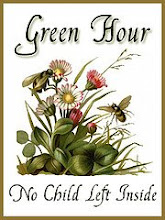I really wanted to share more from this wonderful book on Steiner parenting that I started to blog about last week.
When it comes to toddlers, the Waldorf philosophy - if I get this right - is that young children exist wholly in their physical senses and their will. So for toddlers its all about touching, tasting, hearing, smelling and seeing. They are insatiable for all these wonderful new things. One of the most important things you can do is to pay attention to all that surrounds your child.
This includes the food, clothing, images, toys sunshine, sand and water. It also includes the less tangible ‘nourishment’ that comes from your warmth and love and the emotions that surround your child.
As well as the senses, your toddlers will is developing - their internal drive and motivation is still very instinctual but it is moving from the pure instinct of a baby to the ‘urge’ of a toddler.
According to Steiner, will begins as instinct in a baby, then gradually changes over the years into urge, then desire then motive. Urge is still strongly connected to the body (biological urges) Such urges will further metamorphose into desire when the emotional element enters around the age of two or three.
As you would expect in a Waldorf book, there is a strong aversion to the commercialization of childhood. Caution is suggested in what you bring in to your home, whether through the influence of television, so called ‘educational toys’ like computers for babies, flashcards for toddlers, or structured lessons for pre-schoolers. Instead of these more commercial activities, there is a wonderful list for each age group of suggested toys and things to do.
For example, in the Toddlers chapter she suggests push toys, wooden blocks cut from various diameters of a tree, low containers for water play, a sandbox, a toy telephone, simple dolls, nesting toys, block crayons, and balls. Activities include letting your toddler ‘help’ you around the house, going on nature walks, hiding games, and lots of singing Physical activity is critical for toddlers, and Rahima explains that “when your child is first mastering new body skills, most play consists in pure movement without the element of fantasy. A young child loves to run, jump, walk on tiptoe, climb, run around or roll on the ground. Like a lamb in springtime or a young colt, your child delights in movement for the sheer joy of it”
I particularly enjoyed her suggestions for discipline with toddlers. If you want to teach a certain behaviour to your child, one of the best ways is to actually do it in front of (or with) him. This demands that we as adults get up and actually do something. Movement combined with the smallest amount of fantasy or good humour can go a long way toward getting the child to do what you want… For example, early in the year at our Waldorf preschool, several children couldn’t sit calmly during snack time. “We sit with our feet in front of us’ we repeated again and again, as we reseated the child or showed our own straight way of sitting. After several months the children were older and able to sit calmly during snack time, and the lesson had been repeated so many times that it had begun to penetrate the body.
This is certainly something that I have taken on board with Munchkin.
First published at http://domesticallyblissed.wordpress.com/2008/03/04/you-are-your-childs-first-teacher-the-toddler-years/
Raw Cauliflower Salad
15 years ago






No comments:
Post a Comment